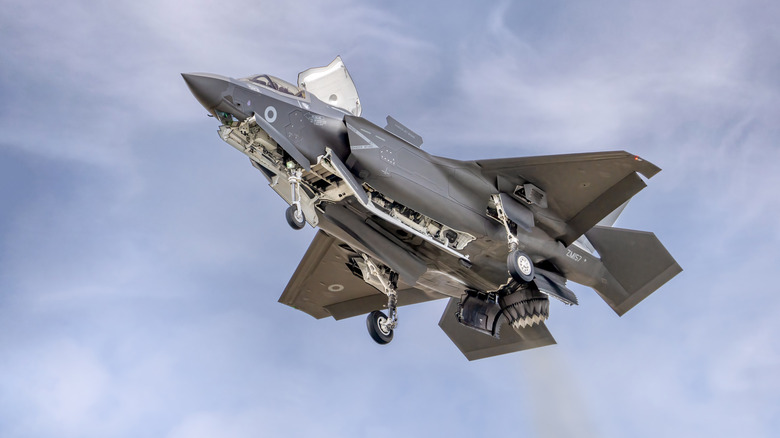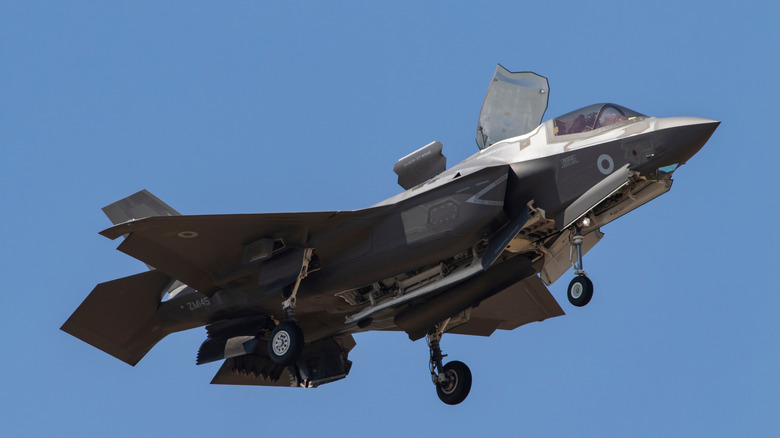What Is The Flap Behind The F-35 Lightning Cockpit And Why Is It Open?
The F-35 Lightning II is perhaps the best example of the indomitable human spirit. Regarded as the most advanced fighter jet to date, this aircraft is truly one of the pinnacle weapons of any military fortunate enough to possess it. The jet has faced its share of controversies, including the very program that developed it, which many consider to be one of the most controversial weapons programs to date. Regardless, the F-35 is a level of power that's hard to find. With its impressive arsenal of weapons, along with cutting-edge stealth and sensor technology, this aircraft possesses all the necessary elements to be formidable. This is to be expected, as multiple countries collaborated to bring it to fruition. Consequently, a range of systems from various companies across the globe is utilized to provide the F-35 with the edge it needs. One of these systems can be identified by the unusual-looking flap behind the F-35's cockpit, which at first glance might appear to cover some concealed tandem cockpit. What exactly is it, and why does it appear on some F-35s while others lack it completely?
The F-35's flap is a crucial piece of equipment that, believe it or not, conceals one of the most impressive systems Rolls-Royce has ever created. Underneath the lid is a powerful fan that, when in use, helps the F-35 hover, make short takeoffs, or land vertically. But, of course, the lid is only the tip of the iceberg. Let's talk about it.
It's all because of Rolls-Royce. Yes, that Rolls-Royce
When the U.S. first conceptualized what would eventually be the F-35 Lightning II, the United Kingdom was present, even sending out its specialists to assist in the effort. As the plans went into development, the U.K.'s very own Rolls-Royce stepped in to lend a hand. Rolls-Royce had previously participated in various airplane projects, developing numerous engines that powered some of the finest aircraft in the U.S. military. However, with the F-35, the company would not be creating a new engine but instead introducing an enhanced version of a system it had already developed and installed in another fighter jet decades earlier.
In the 1950s, Rolls-Royce started working on an engine it would call the Pegasus engine. Essentially, the engine could be connected to swiveling nozzles on a fighter jet's wings, allowing the pilot to direct thrust downward. This would give the aircraft vertical/short takeoff and landing capabilities. The engine was a success, featuring on several Harrier fighter jets. The system Rolls-Royce would install in the F-35 would essentially be a descendant of this engine called the LiftSystem.
In order for the F-35 to hover or execute a short or vertical take-off or landing, the pilot would have to engage the LiftSystem. In such instances, the lid behind the cockpit, where a 50-inch counter-rotating fan is located, would need to open so air can be drawn into the fan.
Only the F-35B comes with the LiftFan installed
The fan is just one component of the LiftSystem. Alone, it can produce upwards of 20,000 pounds of downward thrust. However, that alone wouldn't even come close to helping the F-35 optimally engage in short take-off and vertical landing (STOVL). Luckily, there are more components hidden within the F-35, like roll-posts and a swiveling jet pipe. All of these can produce around 20,000 pounds of thrust, which, when added to the fan's 20,000, effectively allows the jet to hover, vertically land, or successfully execute a short take-off.
The LiftSystem is a crucial system in the F-35, allowing it to switch from conventional flight to STOVL. Even so, not all F35s come with it installed. The F-35 program produced three different types of F-35s: the F-35A, F-35B, and F-35C. Only the F-35B comes with the LiftSystem installed, which means it is the only F-35 with STOVL capabilities. Consequently, it is the only one with the flap behind the cockpit. In the U.S., you'll find F-35Bs in service with the Marine Corps.


